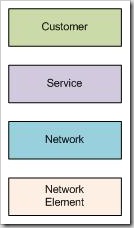Dealing with complexity
The challenge facing TSPs is one of complexity. The systems required to manage telecommunications services are inherently complex and often beyond the scope of the traditional I.T. department to deal with. They require people with a detailed domain knowledge of telecommunications services and I.T. architectures and systems that can support these. An OSS must be able to manage a service delivery process 100 times more complex than the supply chain management (SCM) processes employed by traditional retail and logistics organisations, monitor service performance and availability in real-time, provide information to Customer Relationship (CRM) systems, and collect information that drives financial systems after passing through complicated billing processes. This complexity can be multiplied each time a new network technology is deployed or a new type of service offered. By employing a service management layer to abstracts the complexity of the underlying nework, TSPs can provide an integra...
